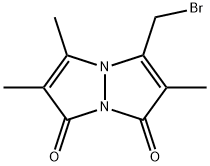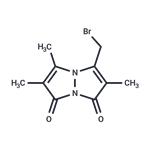Monobromobimane is a thiol-reactive fluorogenic probe. It is cell-permeable, reacts rapidly at physiological pH with available thiol groups, and generates a stable fluorescent signal. Monobromobimane can be used to evaluate or quantify a variety of compounds containing reactive sulfur or thiol groups, including H2S, glutathione, proteins, and nucleotides. The absorption and emission maxima for monobromobimane are 398 and 490 nm, respectively.
Monobromobimane readily reacts with low molecular weight thiols. Bimanes are useful for detecting the distribution of protein thiols in cells before and after chemical reduction of disulfides.
Fluorescence: max. Abs. 398nm; e x 10-3: 5.0
double labeled product that can be fixed with aldehydes for cell-lineage tracing1, neuronal tracing2 and transplantation3.
Monobromobimane is a thiol-reactive fluorogenic probe. It is cell-permeable, reacts rapidly at physiological pH with available thiol groups, and generates a stable fluorescent signal. Monobromobimane can be used to evaluate or quantify a variety of compounds containing reactive sulfur or thiol groups, including H2S, glutathione, proteins, and nucleotides. The absorption and emission maxima for monobromobimane are 398 and 490 nm, respectively.
Monobromobimane is essentially nonfluorescent until conjugated to target molecule. It readily reacts with several low molecular weight thiols, including glutathione, mercaptopurine, peptides and plasma thiols, as well as with carboxylic acids.
ChEBI: A pyrazolopyrazole that consists of 1H,7H-pyrazolo[1,2-a]pyrazole-1,7-dione bearing three methyl substituents at positions 2, 5 and 6 as well as a bromomethyl substituent at the 3-position.

